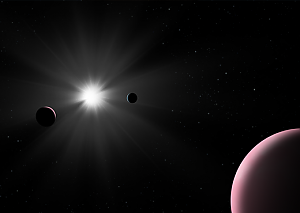Cheops discovers unique exoplanet

The bright, sun-like star named Nu2 Lupi is located just under 50 light-years from Earth in the constellation Lupus (Wolf). While observing its two innermost planets - b and c - in spring 2020, the CHEOPS space telescope unexpectedly discovered the system's third known planet. "At the same time as planet c, planet d also passed by the star, although its orbit is much farther out in the star system," described IWF group leader Luca Fossati, co-author of the study. "Because long-period exoplanets orbit so far from their stars, the chances of seeing them during a transit are incredibly low," Fossati continues. So the CHEOPS find is a minor miracle. For the first time, an exoplanet with a period of more than 100 days has been spotted passing a star bright enough to see with the naked eye.
During a transit, the planet blocks a tiny fraction of light as it passes in front of its star. This light decay also led the CHEOPS team to the extraordinary discovery of Nu2 Lupi d. Transits provide a valuable opportunity to study a planet's atmosphere, orbit, size, and interior. Most long-period exoplanets discovered to date have been found near stars too faint to allow detailed observations. However, Nu2 Lupi is bright enough, making it an extremely attractive target for further observations.
CHEOPS' high-precision measurements revealed that planet d has about 2.5 times Earth's radius, orbits its star in just over 107 days, and its mass is 8.8 times that of Earth. Using the new data, the science team was able to accurately determine the planets' average density. Planet b was found to be composed mostly of rock, while planets c and d are believed to contain large amounts of water surrounded by a small amount of hydrogen and helium. In fact, planets c and d host far more water than Earth: a quarter of their mass is water, compared with less than 0.1% for Earth. "Our calculations show that the gas envelope of the planets was already present when they formed," adds co-author Andrea Bonfanti of IMF.
"Although none of these planets would be habitable, their diversity makes the system even more exciting and offers a great prospect for the future," Fossati said.
Publication
L. Delrez, D. Ehrenreich, Y. Alibert, A. Bonfanti, L. Borsato, L. Fossati, ... W. Baumjohann, ... M. Steller et al.: Transit detection of the long-period volatile-rich super-Earth Nu2 Lupi d with CHEOPS, Nature Astronomy, doi: 10.1038/s41550-021-01381-5, 2021.
